高二英语状语从句小结
- 格式:pdf
- 大小:1.74 MB
- 文档页数:9
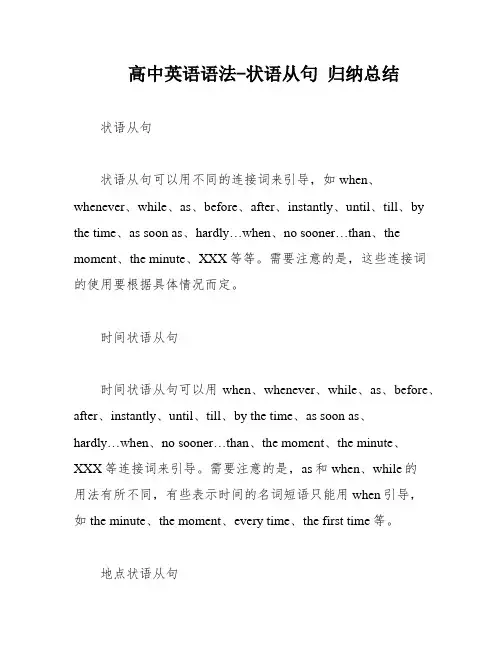
高中英语语法-状语从句归纳总结状语从句状语从句可以用不同的连接词来引导,如when、whenever、while、as、before、after、instantly、until、till、by the time、as soon as、hardly…when、no sooner…than、the moment、the minute、XXX等等。
需要注意的是,这些连接词的使用要根据具体情况而定。
时间状语从句时间状语从句可以用when、whenever、while、as、before、after、instantly、until、till、by the time、as soon as、hardly…when、no sooner…than、the moment、the minute、XXX等连接词来引导。
需要注意的是,as和when、while的用法有所不同,有些表示时间的名词短语只能用when引导,如the minute、the moment、every time、the first time等。
地点状语从句地点状语从句可以用where或XXX来引导。
其中,where 表示某一个地方,而XXX则表示任何一个地方。
原因状语从句原因状语从句可以用because、since、for、as、now that等连接词来引导。
需要注意的是,because语气最强,用来说明人所不知的原因,回答why提出的问题。
而as和since则用来说明显而易见的或已为人们所知的原因。
如果由because引导的从句放在句末并且前面有逗号,则可以用for来代替。
而now that则表示“既然”,需要注意它只能用于现在发生的情况,而since可以用于现在和过去。
条件状语从句条件状语从句可以用if、unless、once、in case、as long as、on n that等连接词来引导。
需要注意的是,多用一般时态,如果表示一般将来的情况,就用一般现在时,如果表示过去将来的情况,就用一般过去时。
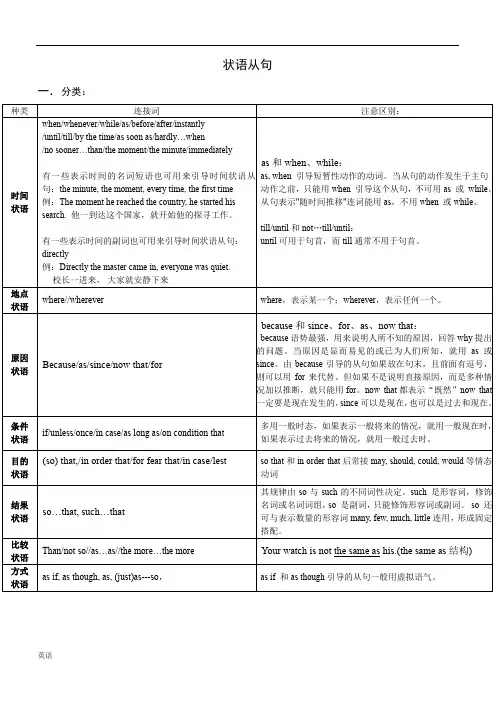
状语从句一.分类:种类连接词注意区别:时间状语when/whenever/while/as/before/after/instantly/until/till/by the time/as soon as/hardly…when/no sooner…than/the moment/the minute/immediately有一些表示时间的名词短语也可用来引导时间状语从句:the minute, the moment, every time, the first time例:The moment he reached the country, he started hissearch. 他一到达这个国家,就开始他的探寻工作。
有一些表示时间的副词也可用来引导时间状语从句:directly例:Directly the master came in, everyone was quiet.校长一进来,大家就安静下来as和when、while:as, when 引导短暂性动作的动词。
当从句的动作发生于主句动作之前,只能用when 引导这个从句,不可用as 或while。
从句表示"随时间推移"连词能用as,不用when 或while。
till/until和not…till/until:until可用于句首,而till通常不用于句首。
地点状语where//wherever where,表示某一个;wherever,表示任何一个。
原因状语Because/as/since/now that/forbecause和since、for、as、now that:because语势最强,用来说明人所不知的原因,回答why提出的问题。
当原因是显而易见的或已为人们所知,就用as或since。
由because引导的从句如果放在句末,且前面有逗号,则可以用for来代替。
但如果不是说明直接原因,而是多种情况加以推断,就只能用for。
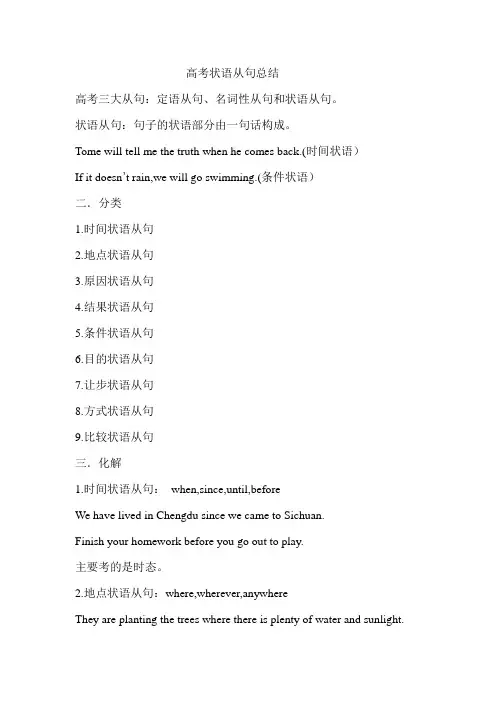
高考状语从句总结高考三大从句:定语从句、名词性从句和状语从句。
状语从句:句子的状语部分由一句话构成。
Tome will tell me the truth when he comes back.(时间状语)If it doesn’t rain,we will go swimming.(条件状语)二.分类1.时间状语从句2.地点状语从句3.原因状语从句4.结果状语从句5.条件状语从句6.目的状语从句7.让步状语从句8.方式状语从句9.比较状语从句三.化解1.时间状语从句:when,since,until,beforeWe have lived in Chengdu since we came to Sichuan.Finish your homework before you go out to play.主要考的是时态。
2.地点状语从句:where,wherever,anywhereThey are planting the trees where there is plenty of water and sunlight.Wherever you go , I will follow you.3.原因状语从句:because,as,for,sinceAs the weather was fine ,we decided to climb up the mountain.Since you have finished your work,let’s go now.4.结果状语从句:so...that,such...thatHe ran so fast that we couldn’t catch up with him.It is such fine weather that we decide to have a picnic.5.条件状语从句:if,unless,as long as,so long as,in case,providedAs long as he is alive,he will work.Take a taxi in case you are late for the class.6.目的状语从句:so that,in order thatHe spoke slowly so that everyone could understand him.You will need to study for many years in order that you may become a doctor.7.让步状语从句:although,though,as(although可放在句首,though不能放在句首)Although he was tired,he still kept working.8.方式状语从句:as,as ifIt looks as if it is going to rain.9.比较状语从句:as...as,thanThis machine is much heavier than that one.四.落地检验——高考真题__volleyball is her main focus,she is also great at basketball.A.SinceB.OnceC.WhileD.Unless___they decide which college to go to,students should research the admission procedure.A.AsB.WhileC.UntilD.OnceOnce bitten ,twice shy.一朝一朝被蛇咬,三年怕井绳。
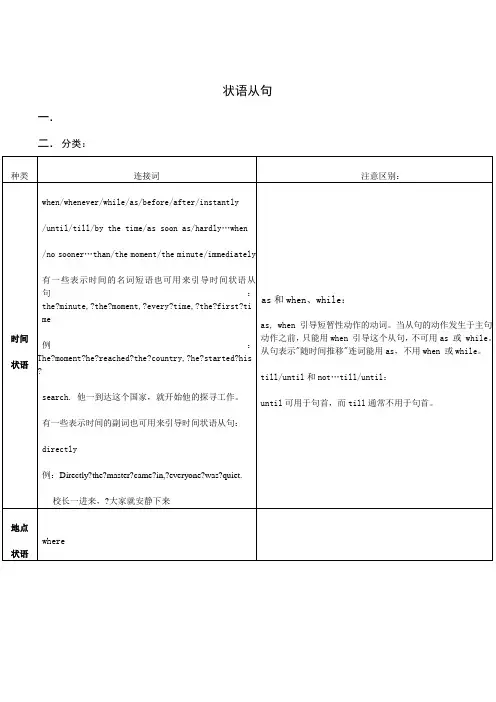
状语从句一.二.分类:adv.+that(如此……以致) so that(结果……)such+n.+that(如果……以致) that(所以,因此)让步状语从句:though/although不可同but连用。
though/although (虽然) however (可是) even though/if(即使)no matter+what/which/where/who/when=whatever/whichever/wherever/whoever/whenever(不论什么/哪一个/哪里/谁/何时)比较状语从句:as (正如)as…as(和……一样)not as/so … as (不如……) than(比……更)the+比较级…+the+比较级(越……越……)条件状语从句:if(假设) unless(如果不) so long as(只要) on condition that (如果)方式状语从句:as(像……那样地) just as(正像) as if(好像) as though(好像)三.四.各种状语从句的简化方法:12.以after和before引导的状语从句的主语若与主句主语一致时,从句等于after/before+doing sth.作状语。
例:After she sang,she left the rich man's house. = After singing,she left the rich man's house.3.4.以as soon as引导的状语从句的主语若与主句主语一致时,从句等于on+doing sth.,作状语,此时的动词为非延续性动词。
例:Mary began to operate on the wounded soldiers as soon as he arrived at the village.= Mary began to operate on the wounded soldiers on arriving at the village.5.6.时间状语从句和条件状语从句的主语和主句主语一致时,有时可简化为不定式作状语。
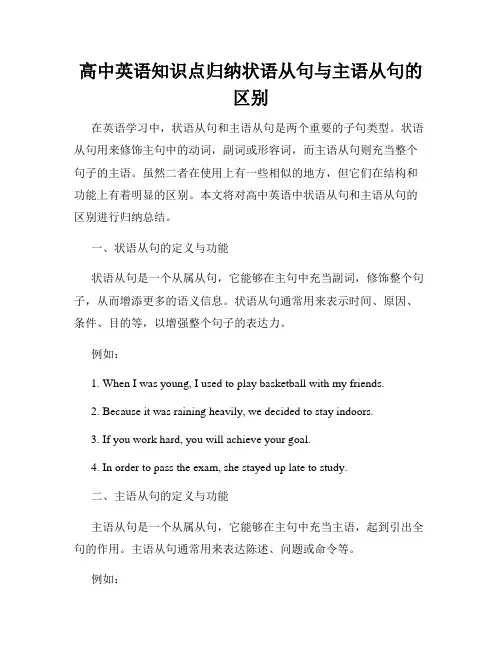
高中英语知识点归纳状语从句与主语从句的区别在英语学习中,状语从句和主语从句是两个重要的子句类型。
状语从句用来修饰主句中的动词,副词或形容词,而主语从句则充当整个句子的主语。
虽然二者在使用上有一些相似的地方,但它们在结构和功能上有着明显的区别。
本文将对高中英语中状语从句和主语从句的区别进行归纳总结。
一、状语从句的定义与功能状语从句是一个从属从句,它能够在主句中充当副词,修饰整个句子,从而增添更多的语义信息。
状语从句通常用来表示时间、原因、条件、目的等,以增强整个句子的表达力。
例如:1. When I was young, I used to play basketball with my friends.2. Because it was raining heavily, we decided to stay indoors.3. If you work hard, you will achieve your goal.4. In order to pass the exam, she stayed up late to study.二、主语从句的定义与功能主语从句是一个从属从句,它能够在主句中充当主语,起到引出全句的作用。
主语从句通常用来表达陈述、问题或命令等。
例如:1. What he said surprised me.2. Whether they can win the game remains to be seen.3. That she is a talented singer is beyond doubt.4. It is important to learn a foreign language.三、状语从句与主语从句的结构1. 状语从句的结构:状语从句通常由引导词引出,包括连词when, while, before, after, since, as soon as, until, unless等;连词because, as, since等表示原因;连词if, unless表示条件;连词so that, in order that表示目的。

高中英语语法状语从句归纳总结Coca-cola standardization office【ZZ5AB-ZZSYT-ZZ2C-ZZ682T-ZZT18】状语从句一.二.分类:such+n.+that(如果……以致) that(所以,因此)让步状语从句:though/although不可同but连用。
though/although (虽然) however (可是) even though/if(即使)no matter+what/which/where/who/when=whatever/whichever/wherever/whoever/whenever(不论什么/哪一个/哪里/谁/何时)比较状语从句:as (正如)as…as(和……一样)not as/so … as (不如……)than(比……更)the+比较级…+the+比较级(越……越……)条件状语从句:if(假设) unless(如果不) so long as(只要) on condition that (如果)方式状语从句:as(像……那样地) just as(正像) as if(好像) as though (好像)三.四.各种状语从句的简化方法:12.以after和before引导的状语从句的主语若与主句主语一致时,从句等于after/before+doing sth.作状语。
例:After she sang,she left the rich man's house. = After singing,she left the rich man's house.3.4.以as soon as引导的状语从句的主语若与主句主语一致时,从句等于on+doing sth.,作状语,此时的动词为非延续性动词。
例:Mary began to operate on the wounded soldiers as soon as he arrived at the village.= Mary began to operate on the wounded soldiers on arriving at the village.5.6.时间状语从句和条件状语从句的主语和主句主语一致时,有时可简化为不定式作状语。


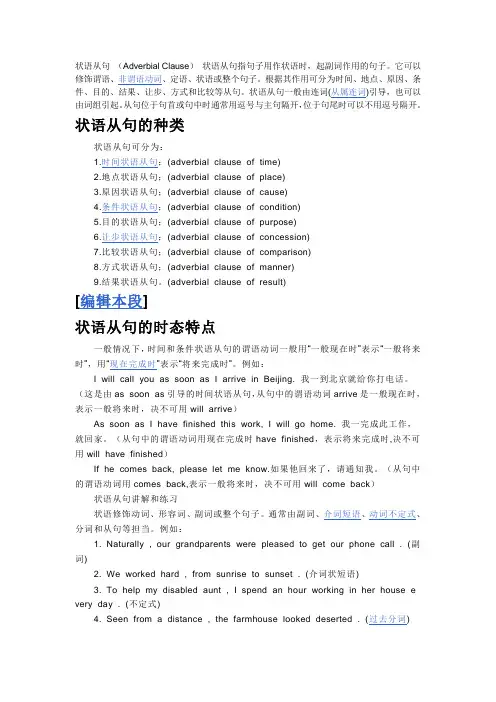
状语从句(Adverbial Clause)状语从句指句子用作状语时,起副词作用的句子。
它可以修饰谓语、非谓语动词、定语、状语或整个句子。
根据其作用可分为时间、地点、原因、条件、目的、结果、让步、方式和比较等从句。
状语从句一般由连词(从属连词)引导,也可以由词组引起。
从句位于句首或句中时通常用逗号与主句隔开,位于句尾时可以不用逗号隔开。
状语从句的种类状语从句可分为:1.时间状语从句;(adverbial clause of time)2.地点状语从句;(adverbial clause of place)3.原因状语从句;(adverbial clause of cause)4.条件状语从句;(adverbial clause of condition)5.目的状语从句;(adverbial clause of purpose)6.让步状语从句;(adverbial clause of concession)7.比较状语从句;(adverbial clause of comparison)8.方式状语从句;(adverbial clause of manner)9.结果状语从句。
(adverbial clause of result)[编辑本段]状语从句的时态特点一般情况下,时间和条件状语从句的谓语动词一般用“一般现在时”表示“一般将来时”,用“现在完成时”表示“将来完成时”。
例如:I will call you as soon as I arrive in Beijing. 我一到北京就给你打电话。
(这是由as soon as引导的时间状语从句,从句中的谓语动词arrive是一般现在时,表示一般将来时,决不可用will arrive)As soon as I have finished this work, I will go home. 我一完成此工作,就回家。
(从句中的谓语动词用现在完成时have finished,表示将来完成时,决不可用will have finished)If he comes back, please let me know.如果他回来了,请通知我。
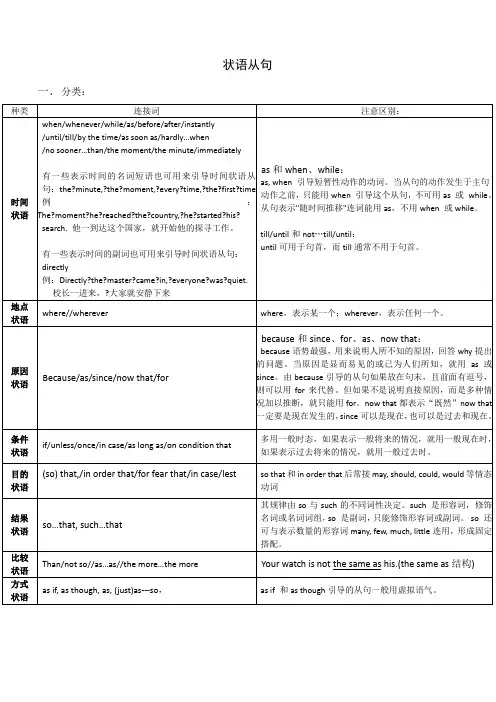
状语从句一.分类:when (当……的时候) while (在……期间) as (当……的时候, 一边……一边……)before (在……之前) since (自从……以来) till/until (直到) hardly…when… (刚……就)as soon as (一……就……)after (在……之后) not…till/until(直到……才)no sooner…than…(刚……就)地点状语从句:where (在那里) wherever(无论哪里)原因状语从句:because (因为) since (因为,既然) as (由于) for (为了) now that(既然)目的状语从句:(so)that=in order that(以便)so as(not)to (以便[不])in case(以免)lest(以免)结果状语从句:so+adj./adv.+that(如此……以致)so that(结果……)such+n.+that(如果……以致)that(所以,因此)让步状语从句:though/although不可同but连用。
though/although (虽然)however (可是)even though/if(即使)no matter+what/which/where/who/when =whatever/whichever/wherever/whoever/whenever(不论什么/哪一个/哪里/谁/何时)比较状语从句:as (正如)as…as(和……一样)not as/so … as (不如……)than(比……更)the+比较级…+the+比较级(越……越……)条件状语从句:if(假设)unless(如果不)so long as(只要)on condition that (如果)方式状语从句:as(像……那样地)just as(正像)as if(好像)as though(好像)二.各种状语从句的简化方法:1作状语。
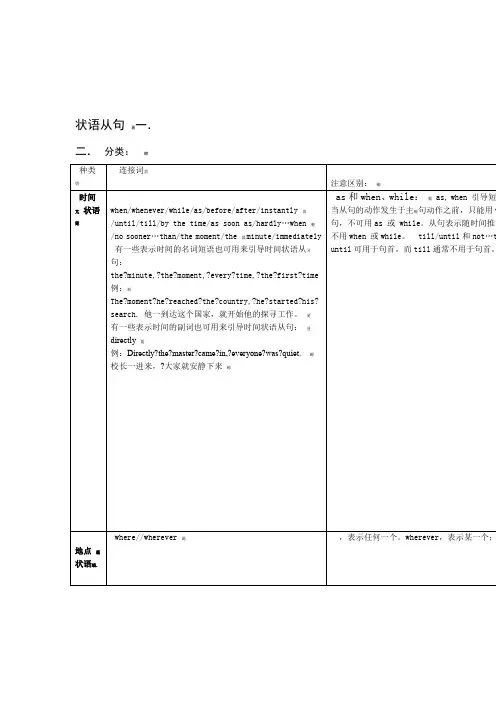
状语从句莃一.二.分类:螃时间状语从句:薇, 一边……一边……)) while (在……期间) as (当……的时候when (当……的时候芃before (在……之前) since (自从……以来) till/until (直到) hardly…when…羁) 刚……就(nonot…till/until(直到……才)) 在……之后 after (一……就……)as soon as (芈.) sooner…than…(刚……就地点状语从句: where (在那里) wherever(无论哪里)蚇(既) since (因为,既然) as (由于) for (为了) now that原因状语从句:because (因为蚄然)lest不]) in case(以免)asorder that(以便) so (not)to (以便[(目的状语从句: so)that=in 蚃(以免)(结果……)状语从句:so+adj./adv.+that(如此……以致) so that结果肇(如果……以致)such+n.+that that(所以,因此)螇连用。
状语从句:though/although不可同but让步肅(即使)(虽然) however (可是) even though/ifthough/although 膁no matter+what/which/where/who/when =whatever/whichever/wherever/whoever/whenever 肀/谁/何时)/(不论什么/哪一个哪里袇(比…… than… as (不如……)as…asas (正如)(和……一样) not as/so 比较状语从句:膂更)the+比较级…+the+比较级(越……越……)袃(如果) so long as(只要) on condition that 状语从句:if(假设) unless (如果不)条件衿方式状语从句:as(像……那样地) just as(正像) as if(好像) as though(好像)羆三.四.各种状语从句的简化方法:薃2.以after和before引导的状语从句的主语若与主句主语一致时,从句等于蒁after/before+doing sth.作状语。
英语状语从句学习心得
从句主要分为三大类,即名词性从句、定语从句和状语从句,名词性从句和定语从句之前都分享了,分别是第3期和第30期,这期给大家分享状语从句,自此从句部分就先告一段落了。
为了增加读者的阅读体验,先普及下什么是状语。
状语:英语中修饰动词、形容词、副词等的成分叫状语。
通常由副词、介词短语、动词不定式、分词等承担。
例:I met him yesterday. 我昨天遇到了他。
(副词yesterday修饰met)
状语从句学习要点
状语从句:指在句子中做状语的从句。
状语从句的作用:常用来修饰主句的谓语动词或整个主句。
例:When we got there,the train had left.(当我们到达时,火车已经开走了,when we got there 修饰谓语动词“开走”)
状语从句学习心得:状语从句是三大从句中相对比较简单的,关键是要掌握引导不同状语从句的引导词及主句和从句的时态选择
时态特点:时间和条件状语从句中,主句为“一般将来时”时,从句要用“一般现在时”;主句为“将来完成时”,从句要用“现在完成时”。
也即大家常听到的“主将从现”。
例:He will not leave if it isn’t fine tomorrow.(如果明天天气不好,他
不会离开)。
英语中状语从句用法及例句总结(完整)状语从句(Adverbial Clause)状语从句指句子用作状语时,起副词作用的句子。
它可以修饰谓语、非谓语动词、定语、状语或整个句子。
根据其作用可分为时间、地点、原因、条件、目的、结果、让步、方式和比较等从句。
状语从句一般由连词(从属连词)引导,也可以由词组引起。
从句位于句首或句中时通常用逗号与主句隔开,位于句尾时可以不用逗号隔开。
状语从句的种类状语从句可分为:1.时间状语从句;(adverbial clause of time)2.地点状语从句;(adverbial clause of place)3.原因状语从句;(adverbial clause of cause)4.条件状语从句;(adverbial clause of condition)5.目的状语从句;(adverbial clause of purpose)6.让步状语从句;(adverbial clause of concession)7.比较状语从句;(adverbial clause of comparison)8.方式状语从句;(adverbial clause of manner)9.结果状语从句。
(adverbial clause of result)[编辑本段]状语从句的时态特点一般情况下,时间和条件状语从句的谓语动词一般用“一般现在时”表示“一般将来时”,用“现在完成时”表示“将来完成时”。
例如:I will call you as soon as I arrive in Beijing. 我一到北京就给你打电话。
(这是由as soon as引导的时间状语从句,从句中的谓语动词arrive是一般现在时,表示一般将来时,决不可用will arrive)As soon as I have finished this work, I will go home. 我一完成此工作,就回家。
高中英语语法状语从句知识点总结高中英语语法状语从句知识点总结相关例句时间状语从句常用引导词:when, as, while, as soon as, before, after, since , not...until特殊引导词:the minute, the moment, the second, every time, the day,the instant( 瞬间,顷刻), immediately , directly(不久,立即), no sooner … than(一...就...), hardly …when(刚一...就...) , scarcely … when(几乎没有……的时候)I didn’t realize how special my mother was until I became an adult.直到我成为了一个成年人我才意识到我的母亲是多么的特殊。
While John was watching TV, his wife was cooking.当约翰在看电视时,他的妻子正在做饭。
The children ran away from the orchard(果园), the moment they saw the guard.孩子们一看到守卫就逃走了。
No sooner had I arrived home than it began to rain.还没等我到家就开始下雨了。
Every time I listen to your advice, I get into trouble.每当我听取你的建议的'时候,我就会惹上麻烦。
地点状语从句常用引导词:where特殊引导词:wherever, anywhere, everywhereGenerally, air will be heavily polluted where there are factories.一般来说,有工厂的地方空气污染就严重Wherever you go, you should work hard.无论你去哪里,你应该努力工作地点状语从句一般由连接副词where, wherever等引导,已经形成了固定的句型,例如:Where there is no rain, farming is difficult or impossible.在没有雨水的地方,耕作是困难的,或根本不可能的。